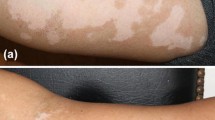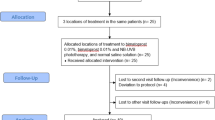Abstract
Background
Targeted UVB intense pulsed light (IPL)-phototherapy has gained interest for repigmentation of vitiligo as it allows selective treatment, sparing the surrounding skin. However, optimal treatment frequency and duration are not known.
Objectives
We compared the efficacy and safety of two treatment protocols, weekly and every two weeks, for a maximum of 12 months. Variables affecting treatment response were evaluated.
Patients & Methods
22 patients (16 female, 6 male; aged 15–67 years) with generalised vitiligo were evaluated retrospectively. UVB-IPL had been administered weekly (13 patients, group A), or every second week (9 patients, group B). In cases of no response, treatment stopped after 6 months. Regimentation was evaluated qualitatively and quantitatively.
Results
After 6 months, 12/13 patients (A), 3/9 patients (B) showed repigmentation. Due to lack of success, treatment was stopped after 6 months in 1 groupApatient and 6/9 group B patients. After 12 months, lesions on the face and trunk in groupAshowed a mean of 70 ± 27% and 60 ± 29% repigmentation, respectively. Moderate to good repigmentation was seen in 78% of group A patients on the ulnar region on the forearms and the shins. Side effects were minimal. Treatment success depended on treatment frequency, number of treatments and the anatomical site of lesions.
Conclusions
UVB-IPL phototherapy seems to be effective and well-tolerated in non-segmental vitiligo. A treatment frequency of weekly intervals rather than every two weeks appears preferable. Our observations will help in designing a sufficiently powered prospective clinical trial to test this hypothesis.
Similar content being viewed by others
References
Krüger C, Schallreuter KU. A review of the worldwide prevalence of vitiligo in children/adolescents and adults. Int J Dermatol 2012; 51: 1206–12.
Fawzy MM, Hegazy RA. Impact of vitiligo on the health-related quality of life of 104 adult patients, using Dermatology Life Quality Index and stress score: first Egyptian report. Eur J Dermatol 2013; 23: 733–4.
Hartmann A, Bröcker EB, Hamm H. Occlusive treatment enhances efficacy of tacrolimus 0.1% ointment in adult patients with vitiligo: results of a placebo-controlled 12-month prospective study. Acta Derm Venereol 2008; 88: 474–9.
Jin Y, Birlea SA, Fain PR, et al. Genome-wide association analyses identify 13 new susceptibility loci for generalized vitiligo. Nat Genet 2012; 44: 676–80.
Schallreuter KU, Bahadoran P, Picardo M, et al. Vitiligo pathogenesis: autoimmune disease, genetic defect, excessive reactive oxygen species, calcium imbalance, or what else? Exp Dermatol 2008; 17: 139–40.
Falabella R, Barona MI. Update on skin repigmentation therapies in vitiligo. Pigment Cell Melanoma Res 2009; 22: 42–65.
Hartmann A, Vitiligo A. Diagnosis, differential diagnosis, and current patient management. Hautarzt 2009; 60: 505–14.
Njoo MD, Westerhof W. Vitiligo. Pathogenesis and treatment. Am J Clin Dermatol 2001; 2: 167–81.
Hartmann A, Bröcker EB, Hamm H. Repigmentation of pretibial vitiligo with calcineurin inhibitors under occlusion. J Dtsch Dermatol Ges 2008; 6: 383–5.
Hartmann A, Löhberg L, Keikavoussi P, Eichner S, Schuler G. Treatment of generalised vitiligo with tacrolimus 0.1% ointment vs. UVB intense pulsed light phototherapy: A pilot study. Acta Derm Venereol 2014. doi: 10.2340/00015555-1740.
Coskun B, Saral Y, Turgut D. Topical 0.05% clobetasol propionate versus 1% pimecrolimus ointment in vitiligo. Eur J Dermatol 2005; 15: 88–91.
Schallreuter KU, Krüger C, Würfel BA, Panske A, Wood JM. From basic research to the bedside: efficacy of topical treatment with pseudocatalase PC-KUS in 71 children with vitiligo. Int J Dermatol 2008; 47: 743–53.
Yuksel EP, Aydin F, Senturk N, Canturk T, Turanli AY. Comparison of the efficacy of narrow band ultraviolet B and narrow band ultraviolet B plus topical catalase-superoxide dismutase treatment in vitiligo patients. Eur J Dermatol 2009; 19: 341–4.
El-Zawahry BM, Bassiouny DA, Sobhi RM, et al. A comparative study on efficacy of UVA1 vs. narrow-band UVB phototherapy in the treatment of vitiligo. Photodermatol Photoimmunol Photomed 2012; 28: 84–90.
Hartmann A, Lurz C, Hamm H, Bröcker EB, Hofmann UB. Narrowband UVB311 nm vs. broad-band UVB therapy in combination with topical calcipotriol vs. placebo in vitiligo. Int J Dermatol 2005; 44: 736–42.
Nicolaidou E, Antoniou C, Stratigos A, Katsambas AD. Narrowband ultraviolet B phototherapy and 308-nm excimer laser in the treatment of vitiligo: a review. J Am Acad Dermatol 2009; 60: 470–7.
Yones SS, Palmer RA, Garibaldinos TM, Hawk JL. Randomized double-blind trial of treatment of vitiligo: efficacy of psoralen-UV-A therapy vs Narrowband-UV-B therapy. Arch Dermatol 2007; 143: 578–84.
Hofer A, Hassan AS, Legat FJ, Kerl H, Wolf P. The efficacy of excimer laser (308 nm) for vitiligo at different body sites. J Eur Acad Dermatol Venereol 2006; 20: 558–64.
Ostovari N, Passeron T, Zakaria W, et al. Treatment of vitiligo by 308-nm excimer laser: an evaluation of variables affecting treatment response. Lasers Surg Med 2004; 35: 152–6.
Asawanonda P, Kijluakiat J, Korkij W, Sindhupak W. Targeted broadband ultraviolet b phototherapy produces similar responses to targeted narrowband ultraviolet B phototherapy for vitiligo: a randomized, double-blind study. Acta Derm Venereol 2008; 88: 376–81.
Lotti T, Buggiani G, Troiano M, et al. Targeted and combination treatments for vitiligo. Comparative evaluation of different current modalities in 458 subjects. Dermatol Ther 2008; 21: 20–6.
Menchini G, Tsoureli-Nikita E, Hercogova J. Narrow-band UV-B micro-phototherapy: a new treatment for vitiligo. J Eur Acad Dermatol Venereol 2003; 17: 171–7.
Park KK, Liao W, Murase JE. A review of monochromatic excimer light in vitiligo. Br J Dermatol 2012; 167: 468–78.
Welsh O, Herz-Ruelas ME, Gómez M, Ocampo-Candiani J. Therapeutic evaluation of UVB-targeted phototherapy in vitiligo that affects less than 10% of the body surface area. Int J Dermatol 2009; 48: 529–34.
Gawkrodger DJ, Ormerod AD, Shaw L, et al. Vitiligo: concise evidence based guidelines on diagnosis and management. Postgrad Med J 2010; 86: 466–71.
Taieb A, Alomar A, Böhm M, et al. Vitiligo European Task Force (VETF). Br J Dermatol 2013; 168: 5–19.
Nicolaidou E, Antoniou C, Stratigos AJ, Stefanaki C, Katsambas AD. Efficacy, predictors of response, and long-term follow-up in patients with vitiligo treated with narrowband UVB phototherapy. J Am Acad Dermatol 2007; 56: 274–8.
Greve B, Raulin C, Fischer E. Excimer laser treatment of vitiligo — critical retrospective assessment of own results and literature overview. J Dtsch Dermatol Ges 2006; 4: 32–40.
Akar A, Tunca M, Koc E, Kurumlu Z. Broadband targeted UVB phototherapy for localized vitiligo: a retrospective study. Photodermatol Photoimmunol Photomed 2009; 25: 161–3.
Hofer A, Hassan AS, Legat FJ, Kerl H, Wolf P. Optimal weekly frequency of 308-nm excimer laser treatment in vitiligo patients. Br J Dermatol 2005; 152: 981–5.
Brazzelli V, Antoninetti M, Palazzini S, et al. Critical evaluation of the variants influencing the clinical response of vitiligo: study of 60 cases treated with ultraviolet B narrow-band phototherapy. J Eur Acad Dermatol Venereol 2007; 21: 1369–74.
Shen Z, Gao TW, Chen L, et al. Optimal frequency of treatment with the 308-nm excimer laser for vitiligo on the face and neck. Photomed Laser Surg 2007; 25: 418–27.
Teulings HE, Overkamp M, Ceylan E, et al. Decreased risk of melanoma and nonmelanoma skin cancer in patients with vitiligo: a survey among 1307 patients and their partners. Br J Dermatol 2013; 168: 162–71.
Schallreuter KU, Tobin DJ, Panske A. Decreased photodamage and low incidence of non-melanoma skin cancer in 136 sun-exposed caucasian patients with vitiligo. Dermatology 2002; 204: 194–201.
Nordal EJ, Guleng GE, Rönnevig JR. Treatment of vitiligo with narrowband-UVB (TL01) combined with tacrolimus ointment (0.1%) vs. placebo ointment, a randomized right/left double-blind comparative study. J Eur Acad Dermatol Venereol 2011; 25: 1440–3.
Author information
Authors and Affiliations
Corresponding author
About this article
Cite this article
Hartmann, A., Schmidt-Habel, A., Löhberg, L. et al. Treatment of vitiligo using targeted UVB-Intense Pulsed Light (IPL)- phototherapy: Evaluation of variables affecting therapeutic success. Eur J Dermatol 24, 551–559 (2014). https://doi.org/10.1684/ejd.2014.2398
Accepted:
Published:
Issue Date:
DOI: https://doi.org/10.1684/ejd.2014.2398




